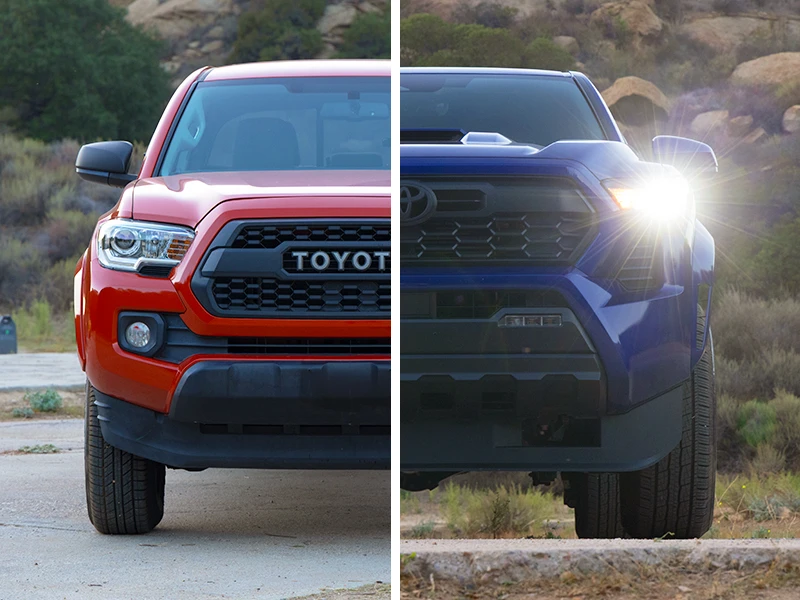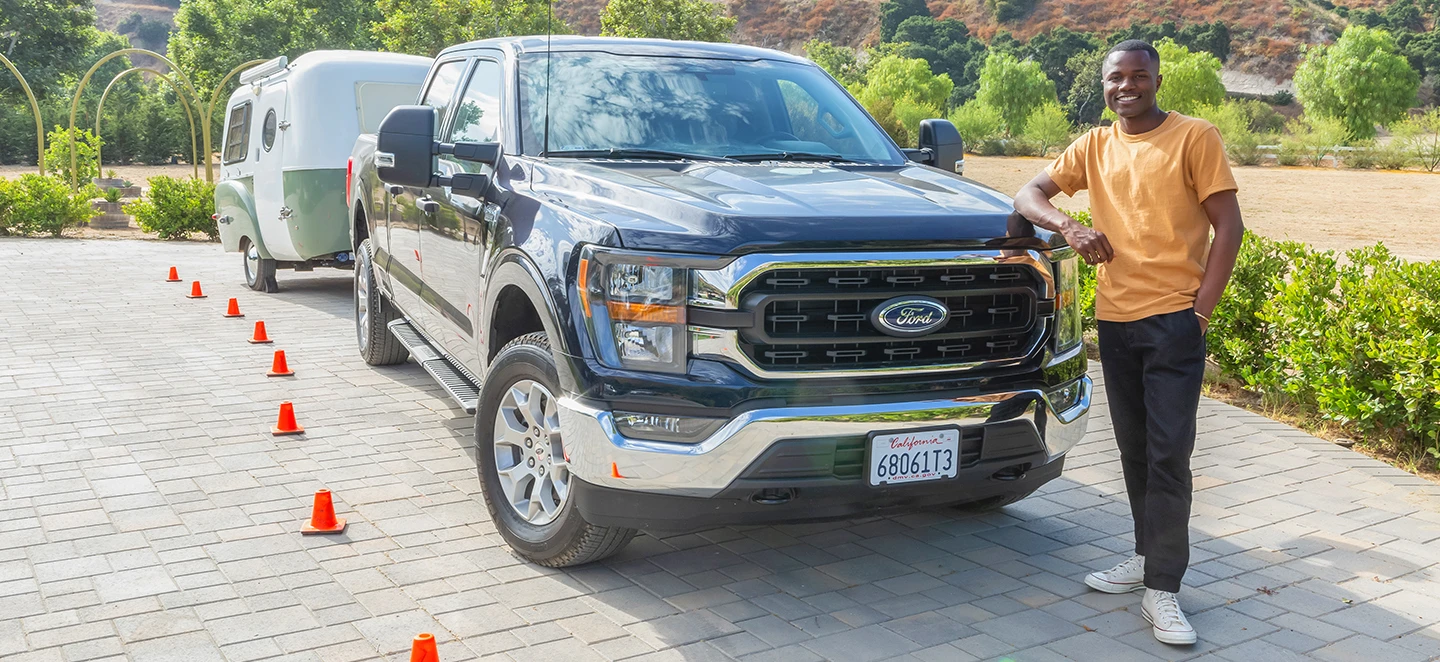
Modern features to know before you shop.
With thousands of vehicles in our inventory, we’re here to help make car research easier for you. We’ve partnered with car review experts from Edmunds to weigh in on what matters most when you’re looking to buy a truck or car.
***
Towing can be challenging whether you're a first-timer or have been towing for years. Thankfully, newer technology from manufacturers ranging from Ford to Toyota can make hauling everything from boats to campers to flatbeds easier. We're going to take a look beyond towing capacity at some modern features so you have an understanding of what’s available before you shop.
Anti-Sway Technology
One commonplace tech these days is anti-sway technology, which is designed to help prevent a trailer from swinging too far left and right, a condition which can cause a crash.
What is trailer sway?
In an ideal world, your trailer follows the path of your vehicle. If you turn the steering wheel to the right, the trailer follows directly behind. In reality, that's not always the case. The weight and distribution of what you're towing, the speed at which you're traveling, and how much you're turning the steering wheel can all lead to a trailer swaying back and forth outside your vehicle's footprint.
What is trailer sway control?
Many companies offer technology to help control trailer sway, including Ford, Chevrolet, and Ram. The technology has been around for more than a decade and is becoming more common as standard equipment on pickups and SUVs. If trailer sway is detected, the truck's onboard computer can adjust torque output, reduce engine power and apply brakes to individual wheels. A message appears on the dashboard warning the driver of trailer sway and to reduce speed, prompting the driver to take their foot off the gas until the trailer stops swaying.
How is trailer sway control different from an anti-sway hitch or bar?
Anti-sway hitches and bars are physical pieces of equipment that try to prevent trailer sway from occurring, while electronic trailer sway control is a piece of software that tries to stop sway once it's already begun. If you're really concerned about trailer sway, you can combine all three of these pieces of technology.
Which vehicles have trailer sway control?
Trailer sway control has been a staple on many trucks and SUVs for more than a decade. These days, you can find the technology on most types of trucks and SUVs with a towing package.
Reversing Technology
Backing up with a trailer is one of the hardest things you can do behind the wheel. While it might make for some funny videos, the reality is that backing up incorrectly can result in damage to what you’re towing, your vehicle, or something else if you accidentally bump into something. Luckily, manufacturers are on it and have come up with some clever technological solutions to help make this tough task a lot easier. We'll tackle features like trailer backup assist and Transparent Trailer below.
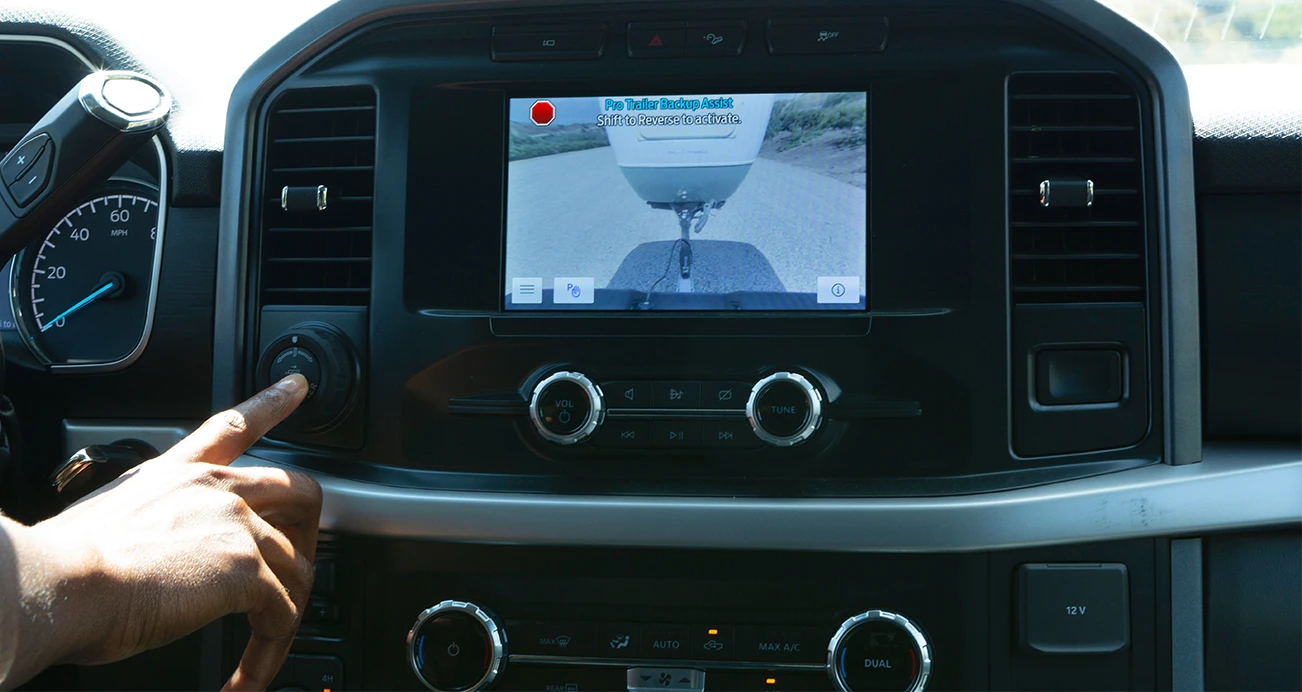
What is Ford’s Pro Trailer Backup Assist™?
Ford's Pro Trailer Backup Assist tries to make backing up with a trailer as easy as turning a knob on the dash. Once the feature is activated, you put your vehicle in reverse and use a knob marked "trailer backup" to control the direction of your vehicle and trailer. Instead of using the steering wheel to change direction, you turn the knob left if you want your trailer to go left and right if you want it to go to the right. There's some setup involved at first so that the system knows how big your trailer is, and it's not adept at really extreme angles. However, once the setup is done it's much easier, especially for a novice, to reverse with a trailer.
How is it different from other backup assist features?
Using the knob to steer your trailer and vehicle is what sets Pro Trailer Backup Assist apart from other backup assist features. By inputting the dimensions of your trailer, your vehicle uses a combination of sensors and its backup camera to make reversing easier.
Is it similar to Toyota's Trailer Backup Guide?
Not exactly, though they're trying to help you do the same thing. Toyota's Trailer Backup Guide is available on the redesigned Toyota Tundra (model year 2022 and later) and, after you've registered your trailer with the vehicle, helps you back it up in an orderly fashion. There are two modes: Guidance and Straight Path Assist. Guidance mode uses an overhead view of your truck to show which direction your trailer is headed, making it easier to make the correct steering inputs. Straight Path Assist helps you backup your trailer by handling the steering while you take care of gas and braking.
What Ford vehicles have Pro Trailer Backup Assist?
Ford made Pro Trailer Backup Assist available starting in the 2015 model year. Today you can find it on the Ford Expedition, Ford F-150, and Ford Super Duty. Keep in mind that this is an optional feature, usually included in one of Ford's towing packages. So if this feature is important to you, you'll want to make sure the vehicle you're looking at comes equipped with the right package.
What is General Motors’ Transparent Trailer?
Unfortunately it is not technically possible to make your trailer invisible. But the Transparent Trailer feature available on some Chevrolet and GMC trucks creates that illusion by using a couple of backup cameras. The software combines footage from the built-in backup camera and an accessory camera on your trailer to allow you to see behind your trailer while towing.

What extra equipment do I need for the Transparent Trailer feature?
You'll need an accessory camera, which you can purchase from Chevrolet or GMC, in order to use this tech. Those systems can cost extra, so keep that in mind if you're interested in using Transparent Trailer.
What GM vehicles have Transparent Trailer?
You can find Transparent Trailer on a handful of Chevrolet and GMC trucks. It's part of an optional towing package beginning with 2020 model years for the Chevrolet Silverado 1500 in addition to the GMC Sierra.
Ford’s Pro Hitch Assist
We've covered some of the backup assistance options you can find on modern trucks, but in 2023, Ford added another improvement to its popular Pro Trailer Backup Assist tech called Trailer Pro Hitch Assist. This new technology makes it easier than ever to connect a trailer and get towing.
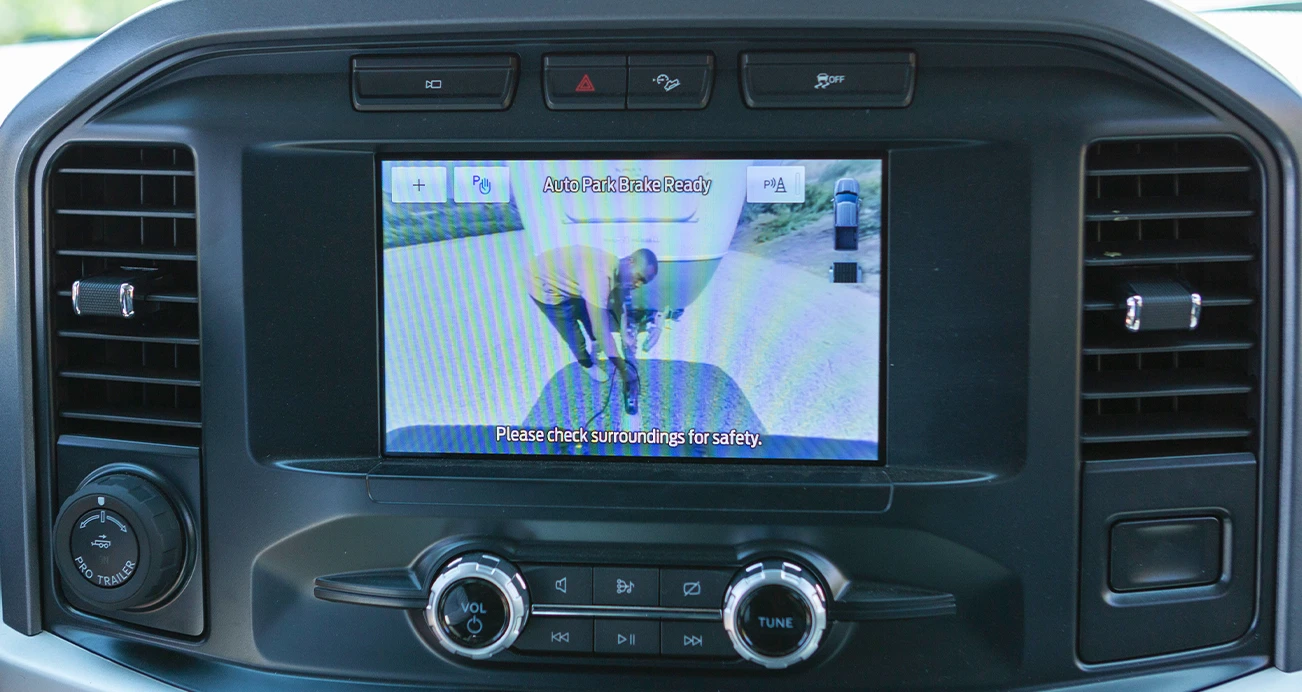
How does Pro Hitch Assist work?
The technology uses the cameras and sensors on the back of the truck to get your tow ball aligned with the hitch all with the press of the button. Implementing it is pretty simple. You hit a button next to the large center touchscreen to activate Pro Hitch Assist. The onboard computer then uses the backup cameras and sensors to detect a nearby hitch and guides the truck backward until the hitch and ball are aligned. The truck takes care of speed, braking, and steering.
So the truck drives itself?
That's the idea! It is a version of semi-autonomous driving, which basically means there are some features and functions the vehicle can do all by itself. It can't drive you out to the lake or to grab a burger yet, so you'll have to handle that yourself.
What Ford vehicles is Pro Hitch Assist available on?
You can find Ford Trailer Pro Hitch Assist on 2023 and newer Ford F-150s, Ford Super Dutys, and the all-electric Ford F-150 Lightning. Other manufacturers have backup assist features, but this particular technology is a Ford exclusive for now.
Extended Blind-Spot Detection
Blind-spot detection is really handy, especially when you're driving a big vehicle — such as pickup, SUV, or an RV. — that has large blind spots to begin with. But until recently, that extra perception ended at the back of the vehicle, making it somewhat useless when towing. However, new technology now makes it possible for that blind spot to include the trailer itself.
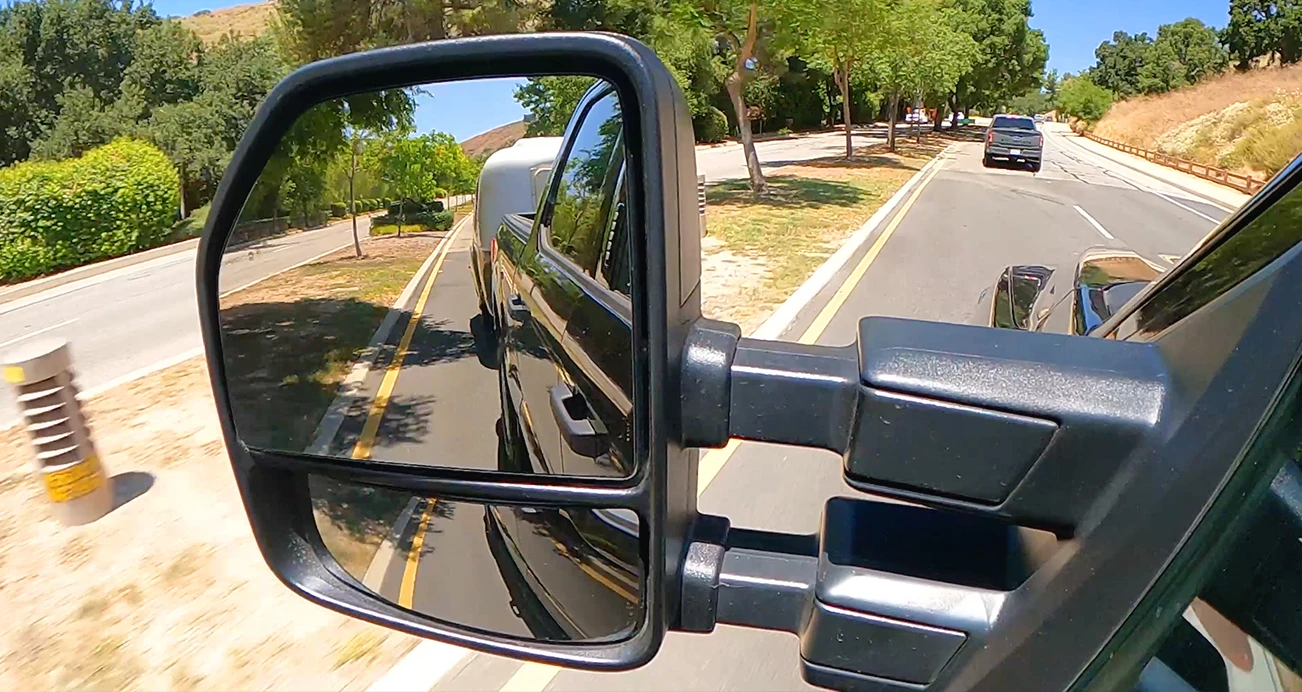
What is extended blind-spot detection?
All vehicles have blind spots of some sort or another, and blind-spot warning systems are an increasingly common driver's aid. Blind-spot warning systems use sensors to monitor for vehicles on either side of you as you drive, and they will flash a warning light near your outside mirror, or even sound a tone, indicating there is something you may not be able to see in your blind spot. Check out our video on how blind-spot warning systems work here.
How does extended blind-spot detection work?
Typically, you'll need to enter the length of whatever you're towing in your vehicle's main screen. Then, your vehicle uses its existing cameras and sensors to check a larger blind-spot area for traffic.
What vehicles have extended blind-spot detection?
You can find extended blind-spot detection on some Ford F-150s (BLIS® with Trailer Coverage); GMC Sierras and Chevrolet Silverados (Trailer Side Blind Zone Alert); Ram 1500s (auto trailer detection) and Toyota Tundras (auto trailer detection). This tech started showing up in 2018 model year Ford F-150s and shortly thereafter on Chevrolet, GMC, and Ram trucks. It debuted on the 2022 Toyota Tundra following its redesign.
Hitchless Towing
Hitchless towing is a prototype technology being worked on by Toyota that does exactly what the name implies: towing without any physical connection.
What is hitchless towing?
As proposed, hitchless towing uses autonomous technology to allow the trailer to follow the lead vehicle in a follow-the-leader format. A human will drive the lead car as usual while the trailing vehicle uses a technology similar to adaptive cruise control to follow behind.
When will I be able to tow a hitchless trailer?
Don't expect to see hitchless towing on a truck or SUV anytime soon. Toyota is still developing this technology, and while the automaker's announcement in September 2022 was heavy on hype, it was light on details. For now, consider this a cool innovation that you might see as a software update in the future, or in vehicles the next time you're shopping for one. Hitchless towing isn't exactly science fiction, but it's also not today's reality.
Conclusion
All this technology can make your life much easier when towing, whether this is your first time or if you've been towing for years. With exciting new technology in development, there's reason to believe towing will only get easier down the road.
